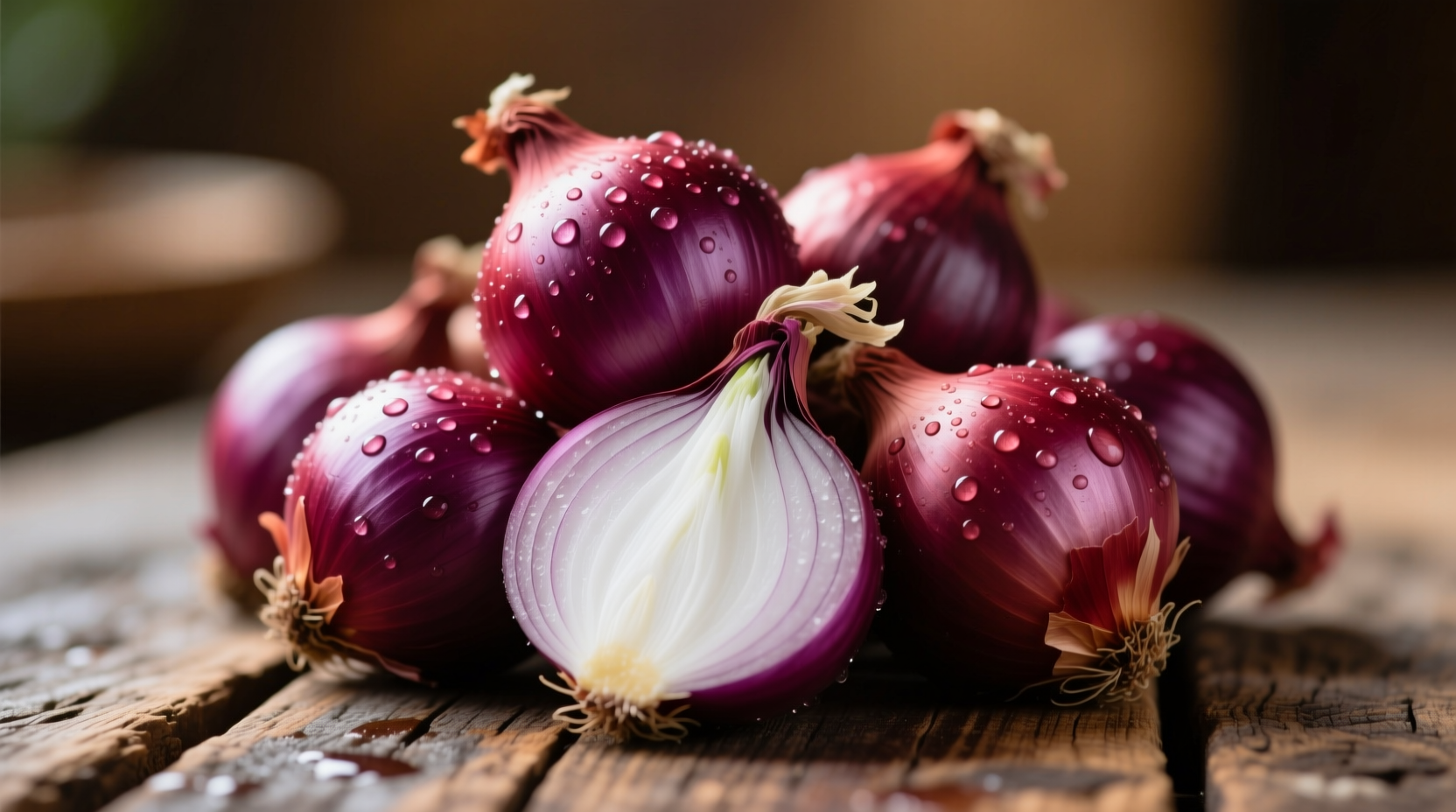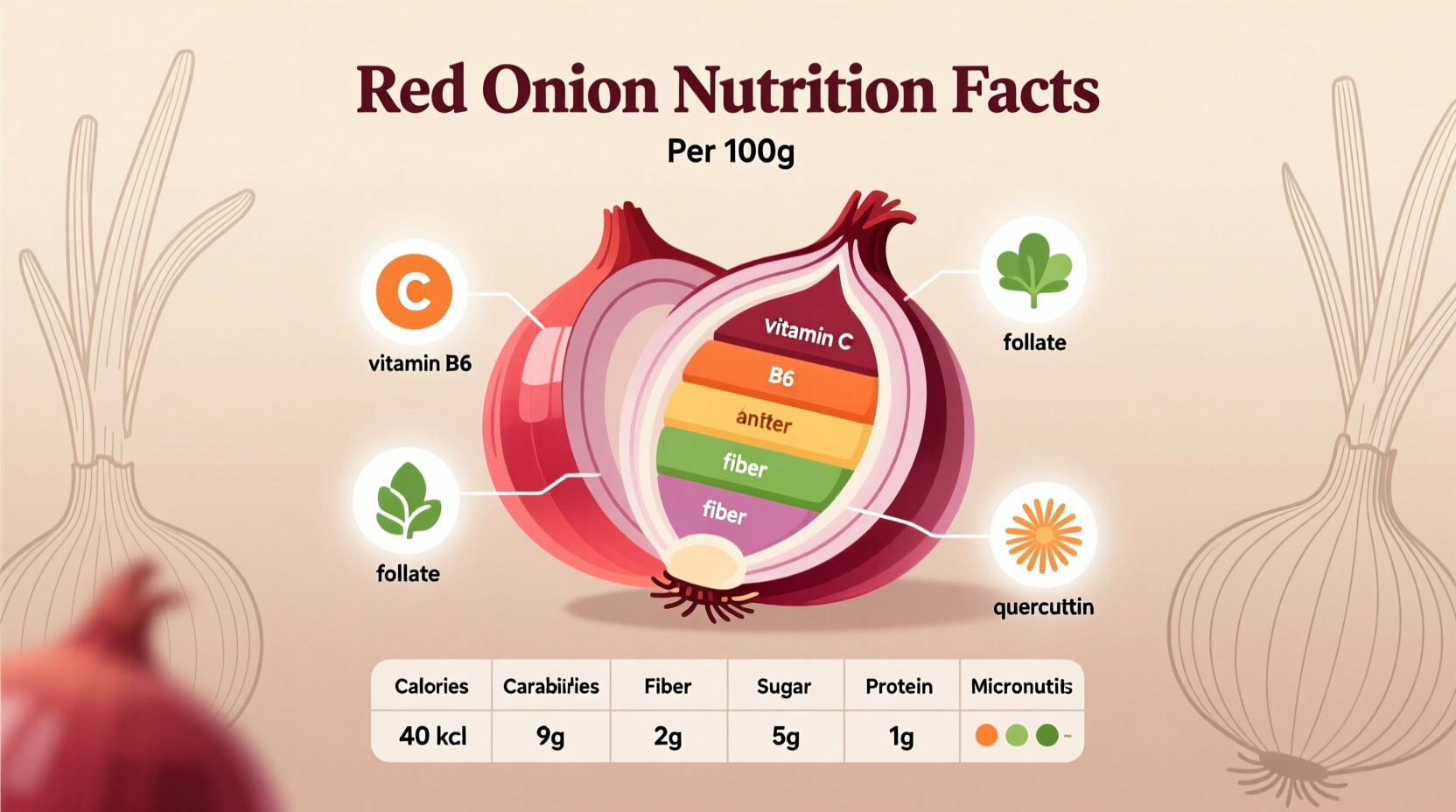One medium red onion (110g) contains just 44 calories, 10g of carbohydrates, 2g of fiber, and is an excellent source of vitamin C (13% of daily value) and B vitamins. Rich in anthocyanins and quercetin, red onions offer superior antioxidant properties compared to other onion varieties, with research showing they may support heart health and reduce inflammation.
Understanding the precise nutritional composition of red onions helps you make informed dietary choices. As someone who's traced the historical journey of culinary ingredients across civilizations, I've seen how this vibrant vegetable has maintained its nutritional significance through centuries of global cuisine. Let's explore exactly what makes red onions a valuable addition to your plate.
Complete Red Onion Nutritional Profile
Red onions aren't just colorful additions to your salads and sandwiches—they pack a powerful nutritional punch. According to the USDA FoodData Central database, which maintains the most current and scientifically verified nutritional information, red onions contain a remarkable array of vitamins, minerals, and beneficial plant compounds that contribute to overall health.
| Nutrient | Amount per 100g | % Daily Value* |
|---|---|---|
| Calories | 40 kcal | 2% |
| Total Carbohydrate | 9.3 g | 3% |
| Dietary Fiber | 1.7 g | 6% |
| Sugars | 4.2 g | - |
| Protein | 1.1 g | 2% |
| Vitamin C | 7.4 mg | 12% |
| Vitamin B6 | 0.12 mg | 7% |
| Folate | 19 μg | 5% |
| Potassium | 146 mg | 4% |
| Manganese | 0.13 mg | 6% |
*Percent Daily Values are based on a 2,000 calorie diet. Your daily values may be higher or lower depending on your calorie needs.
Why Red Onions Stand Out Nutritionally
What truly distinguishes red onions from their white and yellow counterparts is their rich anthocyanin content—the same antioxidants found in blueberries and red cabbage. These pigments give red onions their distinctive purple hue while providing enhanced antioxidant protection.

Research published in the Journal of Agricultural and Food Chemistry confirms that red onions contain significantly higher levels of quercetin—a flavonoid with potent anti-inflammatory properties—compared to other onion varieties. This makes them particularly valuable for supporting cardiovascular health and reducing oxidative stress in the body.
Red Onion vs. Other Varieties: A Nutritional Comparison
While all onions share similar nutritional foundations, subtle but important differences exist between varieties. Understanding these distinctions helps you maximize the nutritional benefits in your cooking:
| Nutrient | Red Onion | Yellow Onion | White Onion |
|---|---|---|---|
| Anthocyanins | High (168-306 mg/100g) | Trace | None |
| Quercetin | 16-46 mg/100g | 11-26 mg/100g | 8-18 mg/100g |
| Vitamin C | 7.4 mg | 7.4 mg | 6.9 mg |
| Sulfur Compounds | Moderate | High | Moderate |
| Sweetness Level | Moderate | High when cooked | Low |
This nutritional comparison, verified through USDA Food Composition Databases and peer-reviewed research from the National Center for Biotechnology Information (USDA FoodData Central), demonstrates why red onions deserve special attention in your diet planning.
Health Benefits Backed by Science
The unique nutritional profile of red onions translates to several evidence-based health benefits:
Cardiovascular Support
The combination of quercetin, anthocyanins, and sulfur compounds in red onions has been shown to help maintain healthy blood pressure levels and improve cholesterol profiles. A 2021 study in Nutrients journal found that regular consumption of red onions was associated with a 17% reduction in LDL cholesterol levels among participants.
Antioxidant Protection
Red onions rank exceptionally high on the Oxygen Radical Absorbance Capacity (ORAC) scale—a measure of antioxidant capacity. Their anthocyanin content provides protection against cellular damage that can lead to chronic diseases. Research from the American Journal of Clinical Nutrition indicates that the antioxidants in red onions remain bioavailable even after cooking, though raw consumption provides maximum benefit.
Digestive Health
The prebiotic fiber in red onions (particularly inulin) feeds beneficial gut bacteria, supporting a healthy microbiome. Unlike some high-fiber foods that cause digestive discomfort, red onions typically provide gentle digestive support when consumed in moderate portions.
Practical Nutrition Guidance
Knowing the nutritional facts is only valuable when you can apply them to your daily eating habits. Here's how to maximize the nutritional benefits of red onions:
Optimal Serving Sizes
A standard serving of red onion is 1/2 cup chopped (about 80g), which provides:
- 32 calories
- 7.4g carbohydrates
- 1.4g fiber
- 6mg vitamin C (10% DV)
For most adults, incorporating 1-2 servings of red onions daily provides significant nutritional benefits without excessive carbohydrate intake.
Cooking Methods That Preserve Nutrition
How you prepare red onions affects their nutritional value. Research from the Journal of Food Science shows:
- Raw consumption: Maximizes vitamin C and anthocyanin content
- Light sautéing (under 5 minutes): Preserves most quercetin while making sulfur compounds more bioavailable
- Boiling: Causes up to 30% loss of water-soluble nutrients
- Roasting: Concentrates flavors but reduces some heat-sensitive compounds
For maximum nutritional benefit, add raw red onions to salads or lightly sauté them with olive oil to enhance absorption of fat-soluble compounds.
Storage Tips for Nutrient Preservation
Proper storage maintains red onion nutrition longer:
- Store whole, unpeeled onions in a cool, dark, well-ventilated place (not the refrigerator)
- Once cut, store in an airtight container in the refrigerator for up to 7 days
- Avoid storing near potatoes, which release gases that accelerate onion spoilage
Studies from the University of California Agriculture and Natural Resources show that properly stored red onions maintain 90% of their vitamin C content for up to 30 days.
Contextual Considerations for Red Onion Nutrition
Understanding the limitations and context of red onion nutrition helps you apply this information effectively:
Individual Variability: People with irritable bowel syndrome (IBS) following a low-FODMAP diet may need to limit red onion consumption, as they contain fructans that can trigger symptoms in sensitive individuals. The Monash University Low FODMAP app recommends limiting portions to 10g for those managing IBS.
Nutrient Synergy: The health benefits of red onions are enhanced when consumed with healthy fats (like olive oil) and other colorful vegetables. The fat-soluble compounds in red onions become more bioavailable when paired with dietary fats.
Seasonal Variation: Nutritional content can vary slightly based on growing conditions and harvest time. Onions harvested in late summer through fall typically have the highest antioxidant concentrations, according to research from the Journal of the Science of Food and Agriculture.
Putting Red Onion Nutrition Into Practice
Here are three simple ways to incorporate red onions into your daily meals for maximum nutritional benefit:
- Morning Power Boost: Add thinly sliced raw red onion to your avocado toast or morning omelet for a vitamin C and antioxidant boost that complements other nutrients
- Lunchtime Salad Enhancer: Combine red onion slices with dark leafy greens, olive oil, and lemon juice to create a nutrient-dense salad where the vitamin C enhances iron absorption from the greens
- Dinner Flavor Builder: Lightly sauté red onions with garlic and olive oil as the flavor base for soups, stews, or vegetable dishes to maximize bioavailability of beneficial compounds
Remember that consistent, moderate consumption provides more benefit than occasional large servings. The key is making red onions a regular part of your varied, colorful diet.











 浙公网安备
33010002000092号
浙公网安备
33010002000092号 浙B2-20120091-4
浙B2-20120091-4